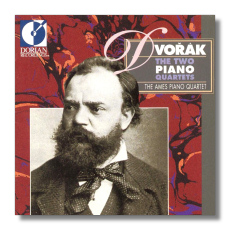
The Internet's Premier Classical Music Source
Related Links
- Dvořák Reviews
- Latest Reviews
- More Reviews
-
By Composer
-
Collections
DVD & Blu-ray
Books
Concert Reviews
Articles/Interviews
Software
Audio
Search Amazon
Recommended Links
Site News
 CD Review
CD Review
Antonín Dvořák

Quartets for Piano & Strings
- Piano Quartet in D Major, Op. 23
- Piano Quartet in E Flat Major, Op. 87
Ames Piano Quartet
Dorian DOR-90125 69:51
Summary for the Busy Executive: Dvořák and Ames – what could be terrible?
The Ames's CD of Richard Strauss's very Brahmsian, relatively early piano quartet (Dorian DOR-90167) made me a fan. The Ames not only displayed technical finish, but also wrung every ounce of meaning from the work and presented a very strong case for this little-known piece as an overlooked masterwork. Strauss isn't particularly known for his early chamber music, and he wrote most of it on his way to "finding himself" as a composer. Much of it consists of awkward cobblings of sonata form, but the piano quartet, at least as the Ames plays it, shows a genius about to "break into blossom."
I've followed the group's recordings ever since. They have yet to disappoint me. They give you more than the "star turn": the feeling of deep study of the music and the concord of individual minds. One never gets the impression that the pianist drives the performance. Their work exemplifies my chamber-music ideal: a conversation among true equals. Familiar music sounds fresh when they play it – in the case of Dvořák, very fresh indeed.
Dvořák wrote his piano quartets almost fifteen years apart. I happen to be nuts about his chamber music, so I'm not really the one to ask how high they rank within his oeuvre. The first shows the composer shaken out of his early Wagnerian fever, with an opening idea strongly based on Czech folk dance. Besides the product of a great composer, it also exhibits an affability suitable for friends gathering at someone's home to make music. It's an eminently "sociable" work. The song-like second movement, although it lacks the strong profile of the first, nevertheless shows Dvořák in an exploratory mood – being both ternary song and theme and variations. The finale also shows the composer's formal daring: it's a rondo with the feel of a scherzo.
The second quartet, an altogether grander affair, sounds less "social" and more ambitious. Dvořák never completely lost his fascination with Wagner, particularly Wagner's harmony, and it certainly comes out here in the many chromatic and enharmonic shifts. However, we still recognize Dvořák himself. The movements are longer, the psychological background a bit more complicated, and the joins aren't as obvious as in the earlier, almost purely lyric work. Brahms would have been proud to have written it. From the opening of the first movement, we know that Dvořák has raised the emotional and aesthetic stakes. We hear a greater emphasis on counterpoint, mostly as a way to vary the texture. Dvořák varies it a lot, resorting to very little melody-with-accompaniment. Again, he satisfies his taste for formal innovation. This comes out most strongly in the third movement, a Brahmsian allegretto with a surprise – a runaway passage that takes the place of a trio. Instead of a relaxation, however, it screws up the tension, leaving the main allegretto to dissipate the excitement. The finale is a headlong rondo with affinities to sonata form. The Ames plays the bejabbers out of it. This disc has become my favorite recording of both quartets.
If I have any quibble, it's with the sound – a bit bass-y. However, I can live with it.
Copyright © 2000, Steve Schwartz


















